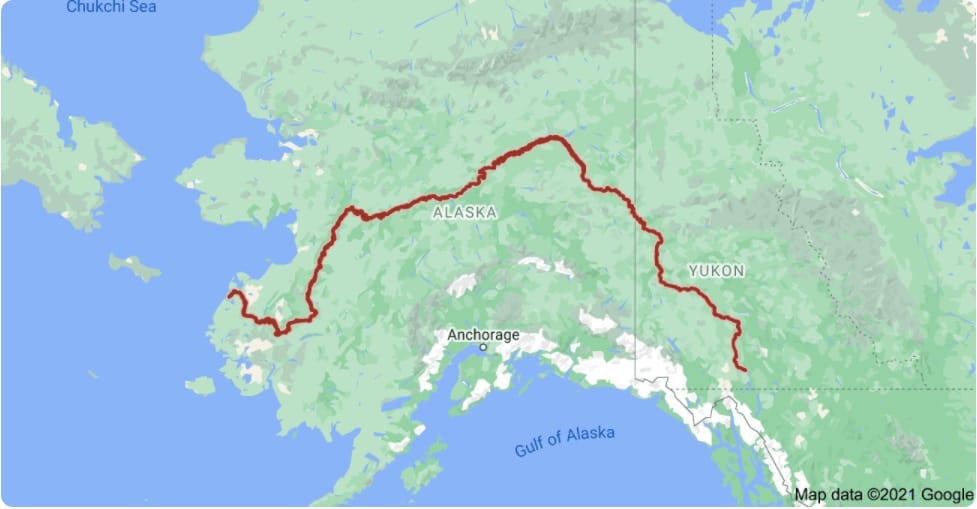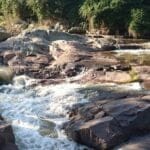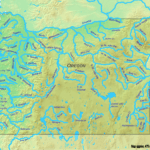Picture this: a journey through the heart of Canada’s water world. We’re going to explore the longest rivers, like the famous Mackenzie and the historic Saint Lawrence. Let’s dive into the stories behind them, unraveling their secrets and the impact they’ve had on Canada’s landscape, people, and wildlife. Along the way, we’ll learn about the challenges these rivers face and the efforts to keep them healthy for the future. Get ready for an unforgettable adventure on the waterways of the Great North!
What are the Longest Rivers in Canada?
Canada, often called the “Great White North,” is famous for its stunning natural beauty, especially its abundance of freshwater. We’re talking massive lakes, rushing waterfalls, and of course – some seriously impressive rivers! But which ones are the true giants, the ones that snake across the landscape for hundreds and hundreds of kilometers?
Let’s dive in and explore the top three longest rivers that call Canada home:
1. The Mighty Mackenzie River System: A Waterway Like No Other (Approximately 4,240 km)
Imagine a river system so vast, so interconnected, that it looks more like a sprawling, watery maze on a map. That’s the Mackenzie River system. Flowing through Canada’s rugged Northwest Territories, it claims the title of not just the longest river in Canada, but one of the longest in the entire world. To put its length into perspective, if you laid the Mackenzie out straight, it would stretch farther than the distance between New York City and Los Angeles!
While the “Mackenzie River” itself might seem like one continuous flow, it’s actually formed by the merging of several major rivers, including the Peace River, the Athabasca River, and the Liard River – each a giant in its own right. This interconnected network of waterways drains a massive area, collecting water from countless lakes, streams, and tributaries along the way.
2. The Yukon River: A Journey Through History and Wilderness (Approximately 3,184 km)
Born high in the Coast Mountains of British Columbia, the Yukon River embarks on an epic journey, carving its way through the heart of the Yukon Territory before finally emptying into the Bering Sea in Alaska. This river isn’t just a stunning force of nature; it’s a living testament to history. For centuries, the Yukon has served as a vital transportation route for Indigenous Peoples, connecting communities and allowing them to thrive in this challenging environment.
Later, during the Klondike Gold Rush of the late 1800s, the Yukon became a lifeline for thousands of prospectors seeking their fortune. While the gold rush might be a distant memory, the river’s allure remains. Today, adventurers and nature lovers still navigate its waters, drawn by the promise of breathtaking scenery, abundant wildlife, and a glimpse into the region’s rich past.
3. The Saint Lawrence River: A Vital Artery of Commerce and Culture (Approximately 3,058 km)
Connecting the iconic Great Lakes to the vast Atlantic Ocean, the St. Lawrence River is more than a picturesque waterway; it’s a critical artery for both the Canadian and US economies. Known for its impressive width and depth, it allows massive cargo ships to travel far inland, transporting goods between the heartland of North America and ports around the globe.
But the St. Lawrence is much more than just a shipping lane. Its shores are dotted with vibrant cities like Quebec City and Montreal, each deeply intertwined with the river’s history and rhythm. For centuries, the St. Lawrence has served as a source of inspiration for artists, writers, and musicians, capturing the hearts and imaginations of those who live along its banks.
What Defines the Longest Rivers in Canada?
Canada is famous for its awesome landscapes, including some seriously long rivers that snake their way across the country. Ever wondered what makes a river “long”? It’s not as simple as just dropping a measuring tape on a map!
A river’s journey begins at its “source.” This could be a glacier melting high up in the mountains, a lake overflowing, or even just a spring bubbling up from the ground. From there, the river flows downhill, picking up water from rain, smaller streams, and melting snow along the way. Finally, the river reaches its “mouth,” where it empties into a larger body of water, like an ocean or a lake.
The distance a river travels from its source to its mouth is what we call its length. So, longer rivers have either traveled a really long distance or taken a winding path to get to their destination!
Surveyors and geographers use special tools and techniques, including satellite imagery and computer modeling, to accurately trace the twists and turns of a river and calculate its total length. The mighty Mackenzie River takes the crown as Canada’s longest, stretching a whopping 4,240 kilometers. It starts its journey in the Rocky Mountains and eventually empties into the Arctic Ocean.
It’s important to remember that the lengths of rivers can vary slightly depending on factors like how they’re measured or even natural changes over time. These awe-inspiring waterways are a testament to the power of nature and the profound connection between rivers and the people who depend on them.
Here’s a look at the approximate lengths of some of Canada’s longest rivers:
| River | Approximate Length (kilometers) |
|---|---|
| Mackenzie | 4,240 |
| Yukon | 3,185 |
| Peace | 1,923 |
| Columbia | 2,000 |
| Athabasca | 1,538 |
Deciding which river is the absolute longest isn’t always crystal clear. Sometimes, rivers change course naturally, or researchers might use slightly different measurement methods. It just goes to show that even when it comes to something as seemingly straightforward as measuring a river, there’s always more to explore!
Exploring Canada’s Mighty Rivers: A Journey Through Geography and Hydrology
Canada’s landscape is truly a sight to behold, and its rivers are like veins running through its heart. The Mackenzie River, for instance, is an absolute behemoth. Stretching over 4,240 kilometers, it holds the title of Canada’s longest river and earns its place among the top 12 longest rivers in the entire world. It’s a testament to the sheer scale of Canada’s wilderness.
Then there’s the Yukon River, another giant among rivers, clocking in at an impressive 3,184 kilometers. This powerful waterway snags the third-place spot for the longest river in North America. It’s not just about size, though. The Yukon River is a lifeline for countless creatures, providing the essentials for a whole ecosystem to thrive.
And of course, we can’t forget the mighty Saint Lawrence River. This iconic waterway stretches a remarkable 3,058 kilometers and is renowned for its sheer volume of water. It’s hard to grasp the immensity of these rivers, but their impact on Canada’s landscape and its people is undeniable.
Beyond these giants, there are over 47 other rivers in Canada that stretch beyond 600 kilometers, each contributing to a vast and interconnected web of life. It’s like a hidden world waiting to be explored!
More Than Just Water: Experiencing the Allure of Canada’s Rivers
Imagine yourself paddling a canoe down a mirror-smooth river, the silence broken only by the call of a loon in the distance. Or maybe you’re kayaking through a canyon, towering cliffs reflected in the water around you. These are just a few glimpses into the magic of experiencing Canada’s rivers firsthand.
The beauty of these rivers goes beyond the aesthetic. They’re steeped in history, their banks whispering tales of Indigenous communities who’ve lived alongside them for generations. Each bend in the river could hold a new discovery, a new connection to the past. Artists, musicians, and storytellers have all drawn inspiration from these waterways, their beauty echoing through art forms across cultures and time.
Guardians of Life: The Vital Importance of River Conservation
Our rivers are more than just pretty views; they’re the lifeblood of our country. They provide the water we drink, irrigate the farms that grow our food, and even offer a source of renewable energy through hydropower. When we protect our rivers, we’re not just protecting nature; we’re protecting ourselves and our future.
However, like many natural treasures around the world, Canada’s rivers face a slew of challenges. Climate change is a major concern, leading to unpredictable water levels and impacting the delicate balance of the ecosystems. Pollution from industrial activities and urban runoff is another growing threat, contaminating the water and harming wildlife.
The good news is that we can all play a part in protecting these precious resources. Simple choices like reducing our water consumption at home, disposing of waste responsibly, and supporting sustainable businesses can make a real difference. By working together to reduce our environmental footprint and advocate for responsible policies, we can help ensure that these magnificent rivers continue to flow for generations to come.
The Ecological and Economic Impact of Canada’s Longest Rivers
Canada’s long rivers – the Mackenzie, the Yukon, the Saint Lawrence – are like the veins and arteries of the country. They support a wealth of life in and around them, from the fish we eat to the birds in the sky. These rivers are also workhorses. They’re like liquid highways, moving goods and supporting businesses. Plus, they’re a big deal for hydropower, giving us cleaner energy.
Consider the Mackenzie River, which stretches over 4,240 kilometers. Recently, it has been dealing with very low water levels, which presents a significant challenge. These low water levels disrupt transportation, making life difficult for people in those areas who rely on the river. Businesses are also feeling the pinch. This situation is a wake-up call – it tells us we need to get serious about managing our water better. Climate change and our industrial activities significantly impact these rivers.
When water levels drop, it’s not just the river that hurts. The whole ecosystem feels it. Fish lose their homes, some species may struggle to survive, and it throws things out of whack. And this environmental trouble can quickly turn into economic trouble. Transportation gets disrupted, hydroelectric power production might take a hit, and those mean job losses and financial problems down the line.
So, what can we do? It’s going to take teamwork. The government, Indigenous communities who’ve lived alongside these rivers for generations, and everyday people all have a part to play. We need to use water wisely, cut down on pollution, and be careful about how we use the land around these rivers. New technology and good science can help us make smart choices for the future. It’s about protecting these rivers so they can keep supporting us for years to come.
If we don’t treat these rivers right, we’re not just messing with nature, we’re messing with our own future.
Discover more about North America’s incredible waterways:
- Discover the towering presence of the 5 biggest rivers in the US and traverse the serene shores of the longest lake in the US.
- Embark on an aquatic odyssey and uncover the grandeur of the main rivers in Canada.
- Crypto Quotes’ Red Flags: Avoid Costly Mistakes - June 30, 2025
- Unlock Inspirational Crypto Quotes: Future Predictions - June 30, 2025
- Famous Bitcoin Quotes: A Deep Dive into Crypto’s History - June 30, 2025

















Comments are closed.